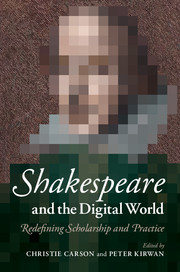Book contents
- Frontmatter
- Contents
- Notes on contributors
- Acknowledgements
- Shakespeare and the digital world
- Part I Defining current digital scholarship and practice
- Part II Defining current digital scholarship and practice
- Half-time: A pause for reflection
- Part III Redefining the boundaries and practices of Shakespeare studies online
- Part IV Redefining the boundaries and practices of Shakespeare studies online
- Index
Part IV - Redefining the boundaries and practices of Shakespeare studies online
Communication and performance
Published online by Cambridge University Press: 05 July 2014
- Frontmatter
- Contents
- Notes on contributors
- Acknowledgements
- Shakespeare and the digital world
- Part I Defining current digital scholarship and practice
- Part II Defining current digital scholarship and practice
- Half-time: A pause for reflection
- Part III Redefining the boundaries and practices of Shakespeare studies online
- Part IV Redefining the boundaries and practices of Shakespeare studies online
- Index
Summary
The previous section of this volume focused on the multiplication of identities as individuals and texts move into the digital world. This section, by contrast, looks at collective identity, institutional identity and the idea that the individual can be part of a number of different larger pieces of work while still maintaining a personal profile and identity. Joint authorship or collective creation relates to a number of ways of working that pre-date the digital world – the science laboratory and the theatrical rehearsal room are two cases in point – however, the digital communications environment allows for simultaneous participation in a wide range of virtual communities that may have very different aims, purposes and underlying structures.
While this is my fifth project for Cambridge University Press I have coedited each of those projects with a different colleague on a different topic. Clearly, I am partial to the collective voice, and the theatrical rehearsal process requires that everyone defer, not to the Director, but to the ‘best idea in the room’.1 I have always been a firm believer in the value of smart rooms and the value of conversation over pronouncement. But I was also trained in the Socratic method from a young age. While the digital world is a conversational one, the fact that communication determines identity and authority in this world means that rhetoric matters almost as much now as it did in Shakespeare’s own time.
- Type
- Chapter
- Information
- Shakespeare and the Digital WorldRedefining Scholarship and Practice, pp. 187 - 192Publisher: Cambridge University PressPrint publication year: 2014



